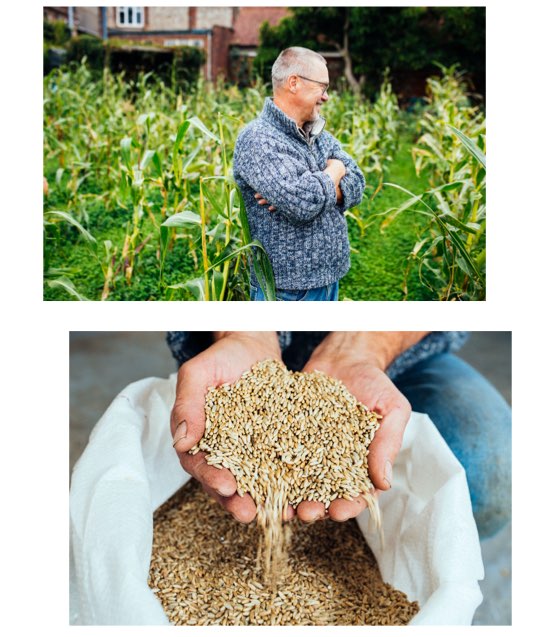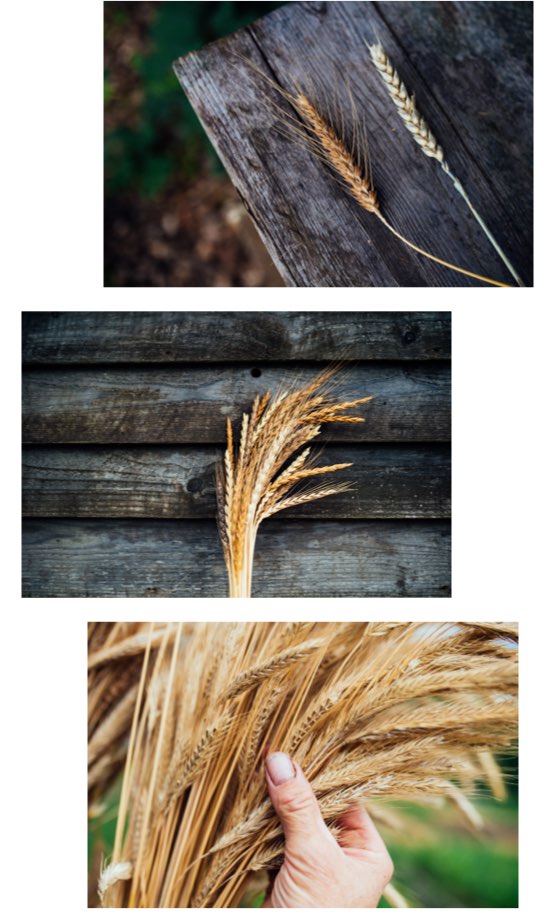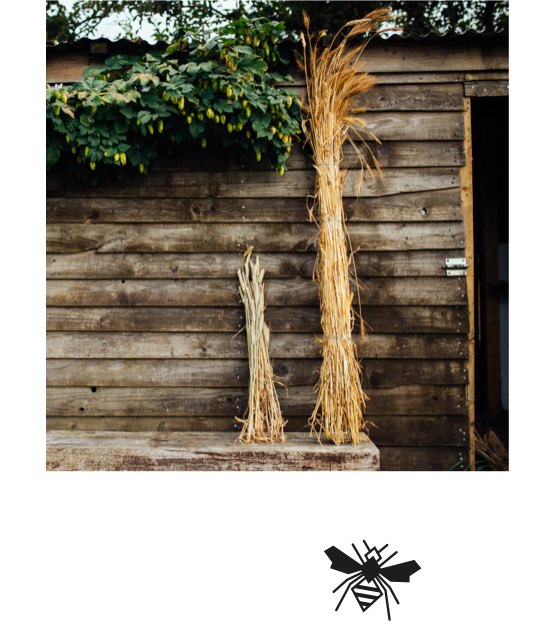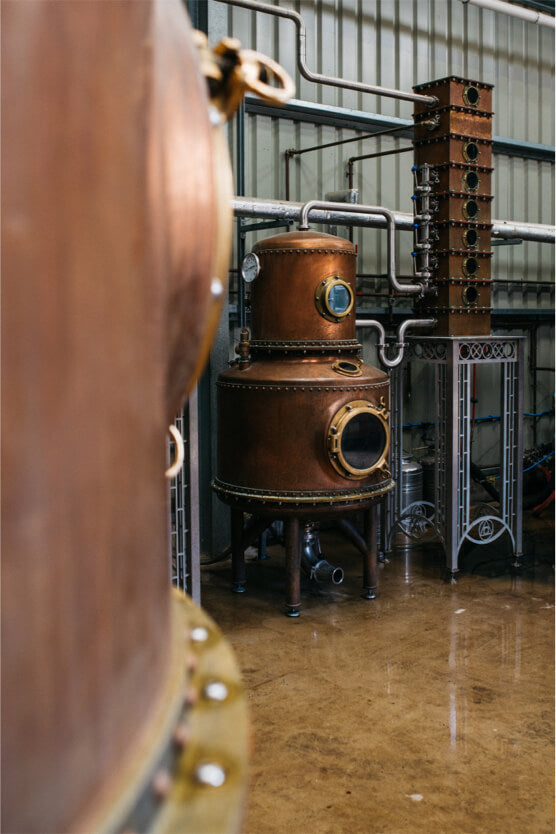
Old Depot, South Park, Cheney Ln, Headington, Oxford OX3 7QJ

Oxford Gin Responsible farming Tested

OXFORD RYE DRY GIN
70 CL | 43% ABV
Regular price£41.00 GBP

Our Oxford Rye Dry Gin is a juniper-forward rye gin using a classic combination of botanicals to give bold notes of juniper, pine and citrus, and a hint of aromatic spice.
Gin recipes are all about telling a story. Our gin recipe tells the story of our fields, starting with the seed that we plant and the heritage grain that we grow. As with everything at The Oxford Artisan Distillery, the gin base is distilled from our heritage grains, grown just for us mostly within 50 miles of Oxford. Eschewing pesticides and chemical fertilisers all of our crops are grown sustainably, contributing to an abundance of wildflowers, insects and birds across our farms.
If a long-time fan of our gin, you might notice a change to our name and label. Previously certified Organic, we have decided to focus on putting our farming first, whilst making no changes at all to how our grain is farmed. This change reflects our commitment to working with all farmers working restoratively as we do (not just those certified Organic), using no chemical inputs whatsoever and putting the soil health first.
Suggested serve: Fill a highball glass with ice and pour in 1 part gin to 3 parts Fever-Tree Refreshingly Light Tonic. Garnish with a slice of tart apple.
BOTANICALS
Juniper, Coriander, Angelica Root, Orris Root, Lemon Peel, Orange Peel, Bitter Orange Peel, Nutmeg, Cubeb, Liquorice Root, Meadowsweet and Angelica Seed.

“This is a hyper-local product which makes an active contribution to biodiversity – world’s away from the industrial alcohol bought in by most distillers. From mother’s ruin to saviour of the planet.”
LUCY SIEGLE, THE GUARDIAN AND OBSERVER
OXFORD BOTANIC GARDEN – PHYSIC GIN
50 CL | 42.1% ABV
Regular price £36.00 GBP

This richly complex gin is a collaboration with and a true celebration of the University of Oxford’s extraordinary Botanic Garden – the oldest of its kind in the country. Founded in 1621 as a physicke (physic) garden for the teaching of herbal medicine, Oxford Botanic Garden was planted during the 1640s by its first keeper, Jacob Bobart the Elder. In 1648, Bobart created a catalogue of all the plants which he grew, now preserved as a treasured ancient manuscript at the Garden. The Oxford Artisan Distillery is the only distillery in the world allowed access to the catalogue and Garden to both inspire and flavour its recipes.

25 unique botanicals, mostly from Bobart’s list and many grown and foraged in the Garden today, give Physic Gin its distinct personality and flavour. Sweet notes of juniper and bay are prominent, with botanicals like wormwood, rue and sweet woodruff bringing a deeply complex flavour. Expect rich, earthy notes from this gin – like nothing you have tasted before. Herbaceous, savoury, and complex, this is a gin that truly represents 400 years of medicinal botanical cultivation.
As with everything at The Oxford Artisan Distillery, the gin base is distilled from our ancient heritage grains. Eschewing pesticides and chemical fertilisers all of our crops are grown sustainably, contributing to an abundance of wildflowers, insects and birds across our farms.
IT ALL BEGINS WITH A GOOD HARVEST
Here at The Oxford Artisan Distillery, responsible farming will always be the first stage in our whisky making; taking our time, regenerating the land and supporting biodiversity with every bottle. Our first batch of organic heritage grain was harvested in the Autumn of 2017, just after we threw open the doors to our distillery for the first time.
ASHMOLEAN DRY GIN
70 CL | 40% ABV
Regular price £41.00 GBP

Our Ashmolean Dry Gin is a collaboration between The Oxford Artisan Distillery and the Ashmolean Museum, the University of Oxford’s Museum of Art and Archaeology and one of Oxford’s most prestigious institutions. Founded in 1683, the Ashmolean’s world famous collections range from Egyptian mummies to contemporary art, telling human stories across cultures and across time.
This spirit is inspired by the Museum’s collections from around the world and is crafted with 17 botanicals including exotic jara lemon, rose, jasmine, and spices from the Middle East and Asia. Full tasting and juniper-led, with notes of cardamom and myrrh, the finish is clean with a lingering taste of orris and lemongrass. This is a spirit to savour in a G&T with 1 part gin to 3 parts light tonic, and garnished with a slice of jara lemon or orange.

As with everything at The Oxford Artisan Distillery, the gin base is distilled from our ancient heritage grains, grown just for us within 50 miles of Oxford. Eschewing pesticides and chemical fertilisers all of our crops are grown sustainably, contributing to an abundance of wildflowers, insects and birds across our farms.
The bottle illustration is Spray of ‘Morning Glory’, by Takeuchi Seiho (1864 – 1942), part of the museum’s Eastern Art collection.
FARMING A NEW APPROACH TO SPIRITS

At the very heart of our spirits is the seed we plant; the seed that grows the grain we distil, that with time and skill (and more time) becomes the spirits we sell, the dram we drink and the moment we share with friends.
And our seed isn’t just any old commercially-grown, bought-in-bulk seed. We are the only distillery using diverse populations of ancient heritage grains – rye, wheat and barley that are adapted to our local growing conditions – to produce our full range of spirits.
It might not be the economical way to produce spirits but the flavour profile these grains produce, and the environmental benefits, pay it back in spades. Our commitment to soil quality, land regeneration, community and the environment goes beyond our passion for spirits.
It was our chance encounter with Oxford-based archaeobotanist, grain expert, and now our farming partner, John Letts, of Heritage Harvest Ltd, at a farmers’ market which, if you’ll excuse the pun, gave our idea its roots and established the fundamentals of our farming.
So what about these ancient heritage grains. Why do they matter? And what does John do that’s so special?

FIRST WE MUST BEGIN WITH A BRIEF LESSON IN BOTANICAL HISTORY
Hunter-gatherers living in the Middle East over 20,000 years ago were the first humans to grind the seeds of wild grasses into flour to make flat breads.
The first domesticated wheat (einkorn) and barley arrived in Britain over 6,000 years ago, and later settlers brought emmer wheat which fed the communities who built Stonehenge. Spelt wheat brought over from the Continent was the staple grain of Provincia Britannia during the Roman period, whereas the Saxons who came after them preferred what is today called ‘common’ bread wheat and rye.
The Danes, Normans and countless generations of Medieval travellers who followed also carried seeds to Britain from Europe and beyond. Those that grew well mixed in with existing crops which slowly evolved into locally-adapted ‘landraces’.
A landrace develops over centuries when a mixed population of crop plants adapts to local growing conditions. It is evolution at its most elementary: varieties that do not grow so well produce less seed and are gradually outcompeted by better adapted lines. This improves the crop’s resilience and its yield. Because growing conditions change from year to year, a landrace also retains a lot of genetic diversity which allows it to adapt to longer term climate change.
In Medieval England every valley, village and manor grew its own unique, genetically-distinctive, landraces of wheat, rye and barley for baking and brewing.
In 1994 John discovered over 200 almost perfectly preserved examples of traditional wheat and rye landraces in the bottom layers of thatched buildings dating from the late Medieval period (1375-1550 AD).
His work showed that, in spite of poor soils, these ancient crops grew to over 1.5 metres tall. and that if these fields had been manured crops would have grown much taller and fallen over in the wind and rain, ruining the harvest.

FEEDING A NEWLY INDUSTRIALISED NATION
Until 1994, no one actually knew what ancient English landraces of wheat or rye had looked like ‘in the field’ because none had survived in cultivation. They were lost when farming in England was industrialised in the early 1800s.
Rye was all but abandoned, and demand rose for purified and higher yielding varieties that produced a lighter, whiter loaf. The landraces that had evolved in farmer’s fields over centuries were gradually replaced by a handful of purified ‘heritage’ varieties selected from the old landraces by seed merchants.
In spite of these changes, and the invention of artificial fertiliser in the 1840s, wheat growing collapsed in the 1880s as Britain was flooded by cheap, high protein (gluten) grain imported from hotter countries such as Canada and the Ukraine.
To save the industry the British government hired scientists to create new ‘hybrid’ varieties that could produce higher quality flour in UK conditions.
The release of ‘Victor’ (1906) revolutionised grain production in England, but these new varieties produced bumper crops only when grown with artificial fertilisers.
In the following decades, and particularly during the so-called ‘Green Revolution’ of the 1960-70s, biodiversity disappeared as crops were dosed with ever-increasing amounts of herbicide, pesticide and fungicide.
Today, our fields are monocultures of uniform ‘dwarf’ wheat varieties that are only a third of the height of older heritage lines, which can be seen in artwork from earlier centuries.
The tall stems of older cereals are matched by their much larger root systems, which allows them to absorb moisture and nutrients from deep below the soil surface. This means they are better at surviving drought, but will also grow very tall and fall over if grown with fertilisers or in rich soil.

SITUATION NORMAL
The Plant Varieties and Seeds Act (1964) sets the rules that govern the characteristics of the varieties that farmers are permitted to grow in the UK. The Act mandates that, in order for its seed to be sold, a new variety must be genetically ‘distinct, uniform and stable’ – characteristics essential only for varieties developed for use in high-input production systems.
Plant Breeder’s Rights legislation gives patent protection for the developer of a new variety so that royalties can be collected on the sale of seed to farmers in order to cover costs and generate profits.
Because creating a new modern variety is so expensive, the legislation ensures that plant breeding is done only by large seed companies, and that all new varieties are designed for intensive, high-input, production systems.
John Letts, and a growing number of ‘alternative’ plant breeders, think there is another way of farming that produces the grain we need while minimising the use of fossil fuels and enhancing biodiversity.
Truly sustainable farming depends on maximising genetic diversity within the crop as well as biodiversity within the field. This was the driving force behind the creation of the genetically-diverse populations of heritage grains that we now use for our unique distillations.
The difference between growing commercial grain and ancient heritage grains? No one can put it better than John:
“A modern wheat field is the opposite of a natural ecosystem. First, you spray the land to eliminate every species growing there. Then you plant one variety of one species (wheat) that is genetically uniform and do everything you can to keep it that way. You spray pesticides to kill the aphids, herbicides to kill the weeds, and fungicides to prevent disease.
You also spray the crop regularly with nitrogen so that it grows as rapidly as possible. All of these chemicals are made from fossil fuels, and more is burned every time the tractor drives up and down the field to spray. Weeds and crop tissues form the bottom of the food chain, and without insects and larger animals, such as birds, have nothing to eat. A modern wheat field is the opposite of a natural ecosystem.”
It is a founding principle of our distillery that grain farming can and should be better; that kind, thoughtful farming methods regenerate the land, encourage biodiversity and make really excellent spirits.

RECREATING THE NATURAL ORDER
The ancient wheat and rye John discovered in Medieval thatched roofs provided direct evidence of the hardy landraces that once grew in English fields.
Thatchers sought out his straw for rethatching works leaving high quality ‘heritage’ grain as a by-product. Guided by the ancient thatch, he collected thousands of samples of wheat and rye from gene banks, traditional farmers and collectors from around the world, and bulked them up on farms and gardens in Buckinghamshire and Oxfordshire.
Most of these samples arrived in packets containing only 25 seeds, which he painstakingly planted, harvested, threshed and bulked up by hand over 15 years. He blended the most suitable varieties together, eventually creating populations that performed well in UK conditions, and which mimicked the diversity that once occurred in traditional landraces.
His modern heritage populations are reliable, adaptable, and produce top quality grain for baking and brewing – and since 2014 for distillation.
Although John’s populations can be grown in standard rotational organic systems, he has developed a new way of growing them that can triple grain output from an organic holding while also sequestering carbon, maximising biodiversity, and minimising the use of fossil fuels.
At The Oxford Artisan Distillery, we think his method of ‘Restorative Grain Production’ (RGP) is the most sustainable way we know of growing grain. The only thing that leaves his fields after the harvest is the grain. The crop is harvested high on the stem leaving most of the straw standing, the next crop is drilled or broadcast into an understorey of short white clover, and the tall stubble and weeds are then chopped over the seed providing a mulch that slowly releases nutrients as it decays which feeds the new crop.
Using this system, grain can be grown in the same field year after year with no reduction in yield or quality. The permanent agro-ecosystem that develops, combined with low levels of nitrogen and high genetic diversity within the crop, minimises problems with pests and diseases.
These crops are productive and resilient and perform particularly well in drought. The maximum annual yield is a little lower than in rotational organic system, but because grain is grown every year the overall output is much higher.
WORKING TOGETHER
Here at The Oxford Artisan Distillery we want to support research into new ways of growing grain without agri-chemicals and that enhance biodiversity. The climate is changing, and the way most grain is grown today is not sustainable.
With every bottle we sell the demand for John’s grain grows, and more land is turned over to his innovative and restorative production methods. We are proud of our work together, and by using his grains we are demonstrating with actions – and not just words – that cereals can be grown profitably, using environmentally friendly methods.
And not by lucky coincidence but by design, heritage grains can be distilled into truly special spirits with the signature maltiness, caramel undertones and silky-smooth mouth feel that make our spirits what they are.
OUR STILLS
From the moment the distillery was a twinkle in our eye, we knew it would be different. Not different for different’s sake, but different to be better; to be more sustainable, more thoughtful, more considerate of the world around us.
With every step of the distilling process carried out with care – from harvesting genetically diverse ancient heritage grains to making our own grain neutral spirit, we knew our stills had to fit our ethos too.
We were never going to import a set of stills from a faraway land, and as still making in England is very rare, our best option was to commission them from scratch.
And so began our collaboration with Paul Pridham and South Devon Railway Engineering, some of the last great historical industrial coppersmiths in England, famous for their refurbishment of the Flying Scotsman.



While we wanted our stills to be functional and to work brilliantly, we also wanted them to be exceptional in every way. So they had to make fantastic spirits, but they also had to be something to behold.
Taking cues from the best of distilling practice, the romance of steam, Victorian engineering, old diving helmets and imagery from Jules Verne’s 20,000 Leagues Under the Sea, our two copper stills were born; Nautilus, our 2,400-litre still, and his 500-litre partner-in-crime, Nemo, weighing in at 940kg and 380kg respectively, together with two five metre tall, 40-plate copper distillation columns.
AS PAUL PRIDHAM SAID OF THEIR CREATION:
“There were so many different skills utilised, from welders, to machinists, fitters and plate workers.
We used traditional casting methods to create connecting rings for the body of the still and 1000 copper rivets to hold it together.
We installed an original porthole salvaged from a ship decommissioned in India to provide a diver’s helmet style opening for cleaning and maintenance, and made others out of brass. It truly was a labour of love.”
HOW TO FIND US
ADDRESS
Old Depot, South Park, Cheney Ln, Headington, Oxford OX3 7QJ
Telephone: 01865 767918
Email: info@theoxfordartisandistillery.com
- LOCATIONSituated in Oxford’s South park, the distillery is a pleasant 30 minute walk from Oxford city centre, great views of the city do come with a price so prepare for some uphill walking! If you are arriving by train to Oxford a taxi will take you about 10 minutes depending on traffic conditions.
- BY BUSTake the number 15 bus towards Wood Farm and get off at the Warneford Hospital stop. From there, The Oxford Artisan Distillery is just a short 300 metres walk away.Alternatively, catch any bus to Oxford Brookes University – either the 8, 9, 280 or U1. We are a five-minute walk from the campus.
- BY CARWe have a small amount of parking available at the distillery. If you are coming from out of town we recommend using the Thornhill Park & Ride, disembarking at the Oxford Brookes University stop.











